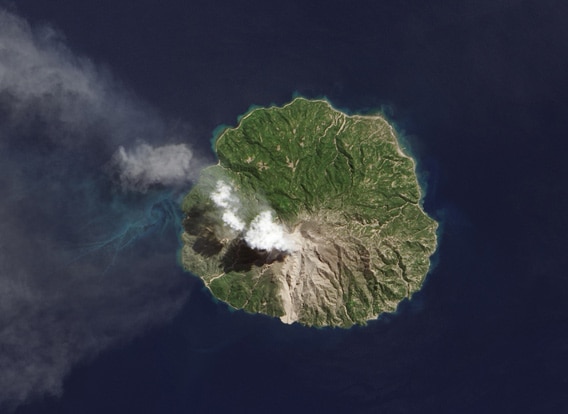Create a free profile to get unlimited access to exclusive videos, sweepstakes, and more!
The Heat and Light of an Active Volcano

In March, NASA launched the newest in the phenomenal Landsat series of satellites, currently called the Landsat Data Continuity Mission, but which will soon be renamed to Landsat 8 once the USGS takes the reins from NASA. It started taking pictures of our planet from space, and itâs already producing some stunning images and great science. It can take simultaneous observations in infrared and visible light, allowing for some pretty interesting and contrasting views of our world.
In late 2012, the Indonesian island volcano Paluweh started erupting, sending out a plume of ash and gas. On Apr. 29, 2013, Landsat passed over it and took two images, one in visible light, and one in infrared. Through the magic of the Interwebz, you can see both below; click and drag the slider splitting the images to compare and contrast the two views:
One of the most obvious differences between the two views is that in the visible light image, the actual hot spot, the volcanic vent where the plume originates, is invisible, hidden by the thick base of the ash plume. But infrared light can travel through that murk, so the hot spot shows up clearly in the IR image. Itâs also clearly defined; in many Earth-observing IR instruments a bright spot can bleed into surrounding pixels, making it look bigger than it actually is. Landsatâs infrared detector was specifically designed to minimize that.
The island is about 15 kilometers (9 miles) across, and the plume stretches for well over 50 kilometers. The visible light image was taken by Landsatâs Operational and Land Imager (you can grab a much larger version of the image online, and you should; itâs beautiful), and the infrared image with the Thermal Infrared Sensor (TIRS), which detects light at a wavelength of 10.6 â 11.3 microns (it can also detect slightly redder light from 11.5 â 12.5 microns as well). The human eye can see light as red as about 0.7 microns, so this well outside what we can see.
The IR image is a little bit fuzzier than its visible light counterpart; the resolution is about 100 meters in IR, compared to 30 meters for the visible. I did the best I could lining them up, but the two images are at an ever-so-slightly different scale, so they donât line up perfectly. Still, itâs fun to see the differences. I was mildly surprised to see that the plume is darker than the water in infrared, for example, implying itâs cooler.
I was also a bit surprised that the different colored waters in the visible light image (the water is lighter and somewhat greener or more teal where itâs shallower) is not seen at all in the IR image. I donât think itâs a resolution issue; some of the greener spots are large enough to see in the IR even at its lower resolution. But water is fairly opaque to light at 11 microns. This means weâre only seeing infrared light emitted (or reflected) from the surface, so changes in depth obvious in visible light canât be seen at all in the IR. Itâs like trying to look through a wall, whereas in visible light itâs like looking through a window. You can see deeper into the water.
What all this means is that you need to use different wavelengths of light to get a better picture of whatâs really going on around you. We see a very thin slice of the Universe with our eyes, but with our big brains we can build detectors that do far better than we can by nature alone. And that in turn helps us study nature, an irony I think is quite lovely.


























